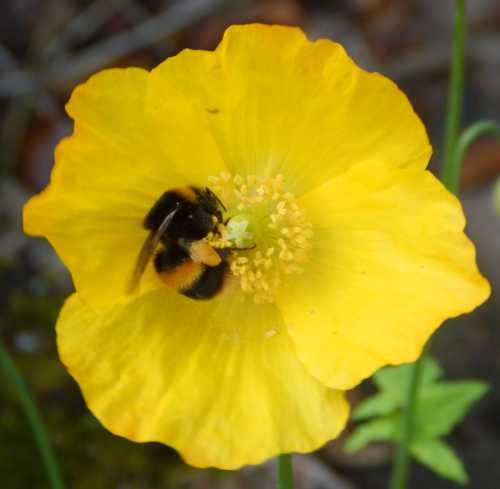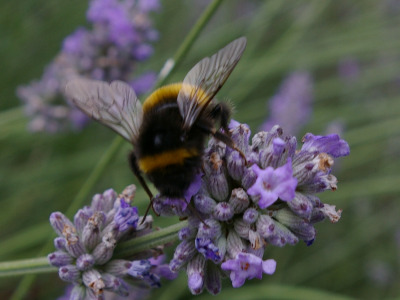Bee Nests FAQs
Updated: December 2023
Many people automatically assume that all bees live in hives. However,
bee nests vary greatly, and as far as hives are concerned, they are of
course a man made contraption designed specifically for keeping honey
bees, and to enable access to the combs and honey for beekeepers. For those who come across a bee nest, one of the most common questions is:
"I have found a bee nest, what should I do?"
It all depends on whether it belongs to bumble bees, honey bees or solitary bees, and the angle from which this question is asked, i.e. 'how do I help' or 'how do I remove it'.
Bee Nests - FAQS
Below is a Q&A with links to help you decide which route to take if you have found a bee nest, plus further information about bee nests generally. If you are urgently needing assistance with a particular scenario, please see the 'Help' section at the bottom, which covers my answers to specific queries received over the years - e.g. what to do about a bee nest in the compost heap, house eaves etc.
Hope the information below helps!
Bumble bee nests
Q: I have found a bee nest with a colony of bumble bees. I’ve heard bees are having a hard time. Is there anything I can do to help the nest to be successful?
Answer:
Yes, bumble bees can benefit greatly from gardens for nesting and foraging1. There are some general ways you can help:
- Keep children and animals away from bee nests.
-
Avoid using pesticides in your garden – even the ones that say they are
safe to use if bees are not foraging. In any event, the foraging times
of different bee species (as well as that of other pollinators) are not
well understood, and may not only depend on the types of bees but also
the species of flower.
- Take a look at the resources on this
site. Perhaps you could supplement your garden with more bee-friendly
plants to provide a long season of pollen and nectar sources?
However,
the most important thing is to try to leave the bumble bee nest alone.
Q: I have found a bumble bee nest, and it appears to be infested with some form of parasite. Is there anything I can do?
Answer:
Not at this point unfortunately. There may or may not be any long-term harm to the colony.
There is some debate about the larvae of a type of hoverfly – Volucella bombylans, which perform the beneficial task of eating debris inside bee nests, although they may eat a few bumble bee larvae too.
Generally, however, it is thought that bumble bees can rear their colonies in any case.
Wax moths, however, are a different matter, and are bad news if they manage to get into bee nests. Wax moths burrow silky tunnels through the clusters of bumble bee brood cells. Although it will be too late for a colony infested with wax moth, an interesting tip I have heard is to place sprigs of mint, mint leaves, or mint in plant pots near to bee nests.
This is believed to deter wax moth, although
whether or not it works for bumble bees, I do not know. Certainly, there are beekeepers who sometimes rub hives with natural mint scented oil diluted
with water in order to deter wax moths.
Q: Where do bumble bees make their nests?
Answer:
It depends on the species. Carder species may nest openly on tufts of grass. Others will use crevices in walls or even roofs or eaves of houses
Some bumble bees use holes in the ground - perhaps abandoned rodent holes or holes naturally caused by formations of tree roots.
Even a compost heap may serve as a nest site for bumble bees.
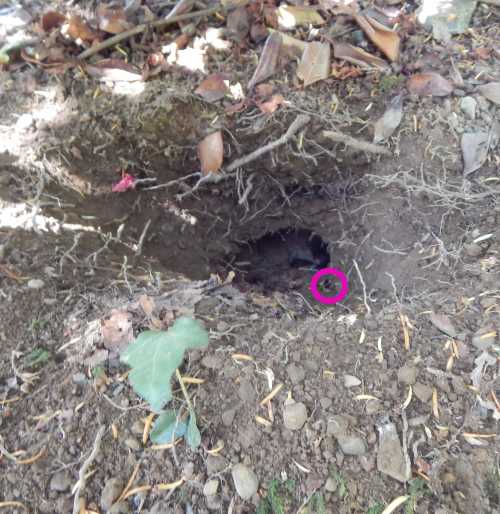 This bumble bee nest is occupied by the white-tailed bumble bee (Bombus lucorum). The pink circle highlights a bee entering the nest.
This bumble bee nest is occupied by the white-tailed bumble bee (Bombus lucorum). The pink circle highlights a bee entering the nest.Some bees prefer to nest in aerial situations, such as nooks and crannies in tree trunks, or inside bird houses.
Q: Is it okay to move a bumble bee nest and will it be okay, or start up a colony elsewhere?
Answer:
Not necessarily, so if you can avoid moving it, the colony will have a greater chance of success. Fewer than half of bumble bee nests are successful, and good nesting sites are hard to come by for bees due to reduction in suitable habitat (e.g. clearing of old hedgerows).
In order to be considered a success, a colony MUST produce new queens, because they are the only bumble bees to survive the winter (following mating, they then hibernate, whereas the rest of the colony will not usually survive). The bumble bees will only be around for a season.
It is time and resource consuming for bumble bees to have to start a new colony and nest, with reduced time available in which to begin the process, and quite possibly fewer suitable flowers for foraging. To explain further, when a queen establishes a colony, there
are many considerations:
- finding a suitable site
- construction of egg cells with wax
- gathering sufficient pollen & nectar to equip the larval cells.
- then there is incubation and larvae development time, and the need to gather more food, and produce workers, males and new queens.
However, if you really feel you must move a nest, please visit my page about bumble bee nest removal for further help and advice.
Honey bees
Q: There’s a great big clump of honey bees on my fence. They arrived yesterday, and I’m worried they’ve decided to nest there.
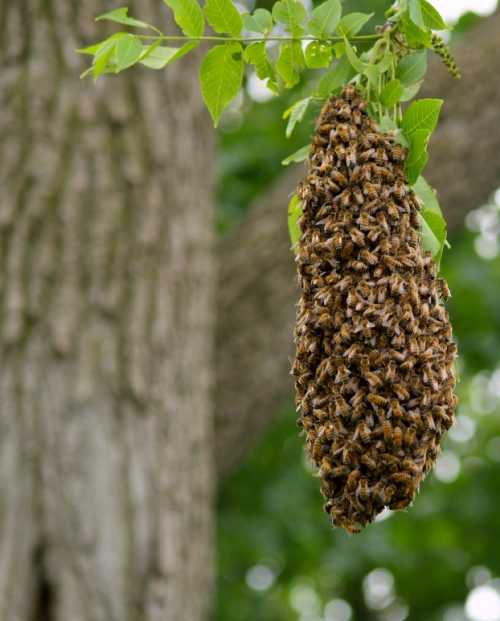 Honey bee (Apis mellifera) swarm.
Honey bee (Apis mellifera) swarm.Answer:
Sounds to me like it’s a honey bee swarm. To learn more about this fascinating natural phenomenon, read this link about
swarming bees.
Contact your local beekeeping association - many are on social media. In the meantime, note that honey bee swarms are only aggressive
if they feel threatened or provoked (in actual fact, a swarm is
relatively docile), but keep your distance anyway.
Also, keep pets and children away from the bees until you have implemented the advice given on the link. For advice follow this link about bee swarm removal.
Q: I’m concerned about a honey bee nest on my property. I don’t know how long they have been there, and I don’t know what to do.
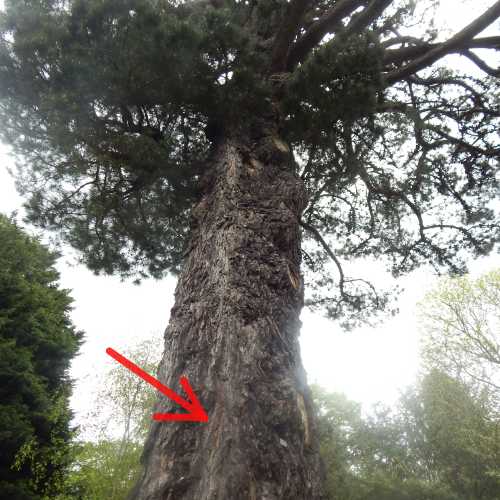 This photograph was taken in winter. There is a wild honey bee nest in this tree. The arrow points to a pale 'vertical' line - this is one of the entrance crevices to the nest.
This photograph was taken in winter. There is a wild honey bee nest in this tree. The arrow points to a pale 'vertical' line - this is one of the entrance crevices to the nest.Answer:
If the honey bee nest is in a natural setting, such as a tree crevice, are you able to leave the nest alone and allow it to remain?
If the nest is in a building and in an inconvenient place, ask a beekeeper to take a look at the situation for you. Honey bee nests need careful handling so as to ensure no honey comb is left behind, because this could attract more bees and wasps after the original honey bees themselves have moved on. A beekeeper will be able to assist in a way that is humane.
If you have difficult locating a beekeeper, you may have to call in a specialist. Try to find one that can remove the nest humanely.
Also see: bees in wall & wall cavities.
Q: I asked a beekeeper to remove a swarm of bees, but he wouldn’t. Surely, it’s his/her duty?
Answer:
Not necessarily, the beekeeper in question may have their own reasons for not being able to assist. Find another beekeeper. Read about swarm removal.
Solitary bees
Q: I’m concerned about the carpenter bees in my garden furniture. I want to get rid of them. What should I do?
Answer:
I have several pages about carpenter bees. Please click my link for more information about
carpenter bees.
Q: I found segments of leaf cut away from my roses. To my surprise I found the culprit – a bee appeared to fly off with a piece of leaf.
I then saw it entering one of the hollow garden canes in my border, where it seems to be living. Was I seeing things? Won’t it damage my plants?
Answer:
Lucky you! You’ve got lovely leafcutter bees
nesting in your garden, providing a pollination service for your border plants.
Does it damage your roses when you dead head or prune them? No, of course not! This little bee should cause no long-lasting harm to your roses or any other plants.
Leafcutter bees will use the leaf segments to construct egg cells.
They only make a few cells, and will only survive a season. Many people
in the know are purposely trying to attract these wonderful little
pollinators, so it’s a real bonus to have attracted leafcutter bees
and this little bee nest into your garden without having made any
special effort!
Q: I've seen just a few bees nesting in the brick work of my garage. What should I do?
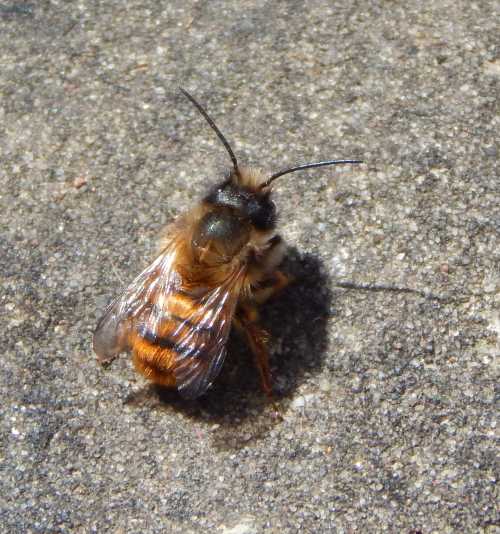 Mason bee
Mason beeAnswer:
Could be mason bees, and they are quite harmless. To learn more about
mason bee nests and help you identify them, follow this link about
mason bees.
References
1. Osborne, J.L., Martin, A.P., Shortall, C.R., Todd, A.D., Goulson, D., Knight, M.E., Hale, R.J. and Sanderson, R.A. (2008), Quantifying and comparing bumblebee nest densities in gardens and countryside habitats. Journal of Applied Ecology, 45: 784-792. https://doi.org/10.1111/j.1365-2664.2007.01359.x
If you found this page helpful or interesting, I'd really be grateful if you would share it with others - if not this page, perhaps another, such as Gardening For Bees.
Thank you so much :) .
